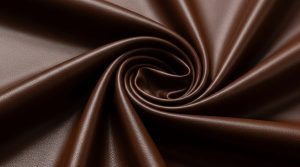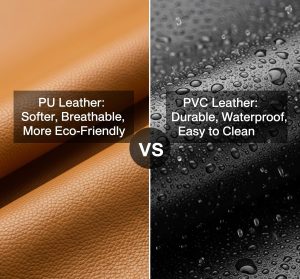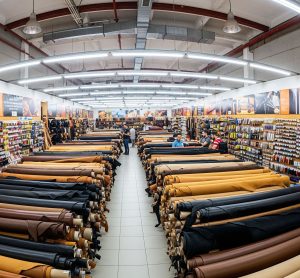In today’s market, distinguishing between genuine leather and PU (Polyurethane) leather can be a challenge, especially with the rise of high-quality synthetic alternatives. PU leather, a popular man-made material, is widely used in furniture, fashion, and accessories due to its affordability, versatility, and vegan-friendly nature. However, knowing whether a product is PU leather or genuine leather is essential for making informed purchasing decisions. This guide provides a detailed exploration of PU leather, why identification matters, and practical methods to differentiate it from real leather, ensuring you choose the right material for your needs.

What is PU Leather?
PU leather is a synthetic material created by applying a layer of polyurethane to a fabric or paper backing. Designed to mimic the look and feel of genuine leather, it offers benefits like water resistance, ease of cleaning, and lower cost. Unlike genuine leather, which comes from animal hides, PU leather is entirely man-made, making it a popular choice for those seeking ethical or budget-friendly alternatives. However, it may not match the durability, natural texture, or aging characteristics of real leather, which can influence its suitability for certain applications.
Why Identifying PU Leather Matters
Understanding whether a product is made from PU leather or genuine leather impacts several aspects of your purchase. Genuine leather is known for its durability, comfort, and ability to develop a beautiful patina over time, making it a premium choice for items like furniture, bags, and shoes. PU leather, while more affordable and easier to maintain, may not last as long and can show signs of wear like cracking or fading. For those with ethical concerns, PU leather’s vegan nature is a significant advantage. Identifying the material ensures you select a product that aligns with your priorities, whether it’s longevity, aesthetics, or ethical considerations.
Methods to Identify PU Leather vs. Genuine Leather
To accurately distinguish PU leather from genuine leather, you can use a combination of visual, tactile, and practical tests. Below are eight reliable methods to help you identify PU leather:
1. Check the Label
The easiest way to determine the material is by checking the product’s label or description. Genuine leather products are typically marked as “Genuine Leather,” “Real Leather,” or “100% Leather.” PU leather, on the other hand, may be labeled as “PU Leather,” “Faux Leather,” “Vegan Leather,” “Synthetic Leather,” or “Man-Made Material.” Be cautious of vague labels, as some manufacturers may use ambiguous terms to obscure the material’s true nature. If the label doesn’t specify, proceed with other tests to confirm.
2. Examine the Surface
Genuine leather has a natural grain pattern with visible pores and slight imperfections, reflecting its organic origin. Each piece is unique, with variations in texture and color. PU leather, being synthetic, often has a uniform, almost too-perfect appearance with a consistent texture. Look closely for natural irregularities—scars, wrinkles, or uneven grain—that indicate genuine leather. If the surface looks overly smooth or lacks variation, it’s likely PU leather.
3. Inspect the Backside
Turn the material over to check its backside. Genuine leather typically has a suede-like, fibrous, or fuzzy texture on the reverse side, a result of its animal hide origin. PU leather, however, has a fabric or plastic backing, which is a clear indicator of its synthetic composition. This difference is especially noticeable in items like bags or furniture where the underside is accessible.
4. Feel the Texture
Touch is a powerful tool for identification. Genuine leather feels soft, supple, and warm to the touch, with a natural give and slight imperfections. PU leather, in contrast, feels colder, smoother, and more rigid, often resembling plastic. It may also have a slightly sticky or stretchy quality due to the plasticizers used in its production. Run your hand over the material to compare its warmth and flexibility.
5. Smell the Material
The smell test is a quick and effective method. Genuine leather has a distinct, rich, earthy scent that is unmistakable once you’re familiar with it. PU leather, being synthetic, often carries a chemical or plastic-like odor, especially when new. Some manufacturers may try to mask this with artificial scents, but a strong plastic smell is a telltale sign of PU leather.
6. Perform the Water Test
A simple water test can reveal the material’s nature. Place a few drops of water on an inconspicuous area of the surface. Genuine leather, being porous, will absorb the water, often darkening slightly as it does. PU leather, with its non-porous polyurethane coating, will repel water, causing the droplets to sit on the surface or roll off. This test is particularly useful for confirming your suspicions but should be done carefully to avoid damaging the product.
7. Consider the Price
While not foolproof, price can provide clues. Genuine leather products are generally more expensive due to the cost of sourcing and processing animal hides. If a product seems unusually affordable for its claimed material, it’s likely PU leather. However, some high-end brands may price vegan leather items higher, so use this method alongside others for accuracy.
8. Observe Aging and Wear
Over time, genuine leather develops a patina—a natural sheen that enhances its beauty—and becomes softer and more supple. PU leather, however, may crack, tear, or fade with prolonged use or exposure to sunlight. If you have access to older items, check for signs of aging. Genuine leather tends to age gracefully, while PU leather shows wear more quickly, often losing its original appearance.
Test Method | Genuine Leather | PU Deri |
Label | Labeled “Genuine Leather” or “Real Leather” | Labeled “PU Leather,” “Faux,” or “Synthetic” |
Surface Appearance | Natural grain, pores, imperfections | Uniform, too-perfect texture |
Backside | Fibrous, suede-like texture | Fabric or plastic backing |
Texture | Soft, warm, supple | Cold, smooth, plastic-like |
Smell | Earthy, natural | Chemical, plastic-like |
Water Test | Absorbs water, may darken | Repels water, droplets sit on surface |
Price | Generally more expensive | Often more affordable |
Aging | Develops patina, ages gracefully | May crack, tear, or fade |
Practical Tips for Accurate Identification
- Combine Multiple Tests:Some high-quality PU leathers are designed to closely mimic genuine leather, so relying on a single method may not be enough. Use a combination of label checks, visual inspections, and tactile tests for the best results.
- Look for Certifications:Some genuine leather products come with certifications or stamps from tanneries or organizations that verify authenticity. These can provide additional assurance.
- Consult Experts:If you’re uncertain, seek advice from a leatherworker or professional who can assess the material based on experience.
- Test Discreetly:When performing tests like the water test, choose an inconspicuous area to avoid damaging the product, especially if it’s new or expensive.
Caring for PU Leather
If you confirm that your item is PU leather, maintenance is relatively simple. Wipe it with a damp cloth and mild soap to clean spills or stains. Unlike genuine leather, PU leather doesn’t require conditioning, but avoid harsh chemicals or abrasive cleaners to prevent damage. Store PU leather items away from direct sunlight to minimize fading or cracking.
Sonuç
Identifying PU leather versus genuine leather involves a combination of observation, touch, and practical tests. By checking labels, examining texture, smelling the material, and performing tests like the water test, you can confidently determine whether a product is PU leather or genuine leather. This knowledge empowers you to make informed choices when purchasing furniture, clothing, or accessories, ensuring you select a material that meets your needs for durability, aesthetics, or ethical considerations. Whether you value the timeless quality of genuine leather or the affordability of PU leather, these methods will help you shop with confidence.







